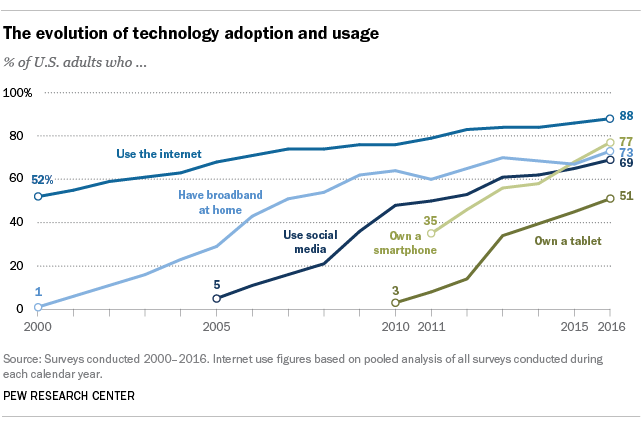
Nearly nine-in-ten Americans today are online, up from about half in the early 2000s. Pew Research Center has chronicled this trend and others through more than 15 years of surveys on internet and technology use. On Thursday, we released a new set of fact sheets that will be updated as we collect new data and can serve as a one-stop shop for anyone looking for information on key trends in digital technology.
To mark the occasion, here are four key trends illustrating the current technology landscape in the U.S.
Roughly three-quarters of Americans (77%) now own a smartphone, with lower-income Americans and those ages 50 and older exhibiting a sharp uptick in ownership over the past year, according a Pew Research Center survey conducted in November 2016. Smartphone adoption has more than doubled since the Center began surveying on this topic in 2011: That year, 35% of Americans reported that they owned a smartphone of some kind.
Smartphones are nearly ubiquitous among younger adults, with 92% of 18- to 29-year-olds owning one. But growth in smartphone ownership over the past year has been especially pronounced among Americans 50 and older. Nearly three-quarters (74%) of Americans ages 50-64 are now smartphone owners (a 16-percentage-point increase compared with 2015), as are 42% of those 65 and older (up 12 points from 2015). There has also been a 12-point increase in smartphone ownership among households earning less than $30,000 per year: 64% of these lower-income Americans now own a smartphone.
After a modest decline between 2013 and 2015, the share of Americans with broadband service at home increased by 6 percentage points in 2016. Between 2013 and 2015, the share of Americans with home broadband service decreased slightly – from 70% to 67%. But in the past year, broadband adoption rates have returned to an upward trajectory. As of November 2016, nearly three-quarters (73%) of Americans indicate that they have broadband service at home. But although broadband adoption has increased to its highest level since the Center began tracking this topic in early 2000, not all Americans have shared in these gains. For instance, those who have not graduated from high school are nearly three times less likely than college graduates to have home broadband service (34% vs. 91%). Broadband adoption also varies by factors such as age, household income, geographic location and racial and ethnic background.
Even as broadband adoption has been on the rise, 12% of Americans say they are “smartphone dependent” when it comes to their online access – meaning they own a smartphone but lack traditional broadband service at home. The share of Americans who are smartphone dependent has increased 4 percentage points since 2013, and smartphone reliance is especially pronounced among young adults, nonwhites and those with relatively low household incomes.
Nearly seven-in-ten Americans now use social media. When the Center started tracking social media adoption in 2005, just 5% of Americans said they used these platforms. Today, 69% of U.S. adults are social media users. Social media is especially popular among younger adults, as 86% of 18- to 29-year-olds are social media users. But a substantial majority of those ages 30-49 (80%) and 50-64 (64%) use social media as well. Only about one-third (34%) of Americans 65 and older currently use social media, but that figure has grown dramatically in recent years: As recently as 2010, only around one-in-ten Americans age 65 and older used social media.
Half the public now owns a tablet computer. Though less widespread than smartphones, tablet computers have also become highly common in a very short period of time. When the Center first began tracking tablet ownership in 2010, just 3% of Americans owned a tablet of some kind. That figure has risen to 51% as of November 2016.
Related posts:
A third of Americans live in a household with three or more smartphones
